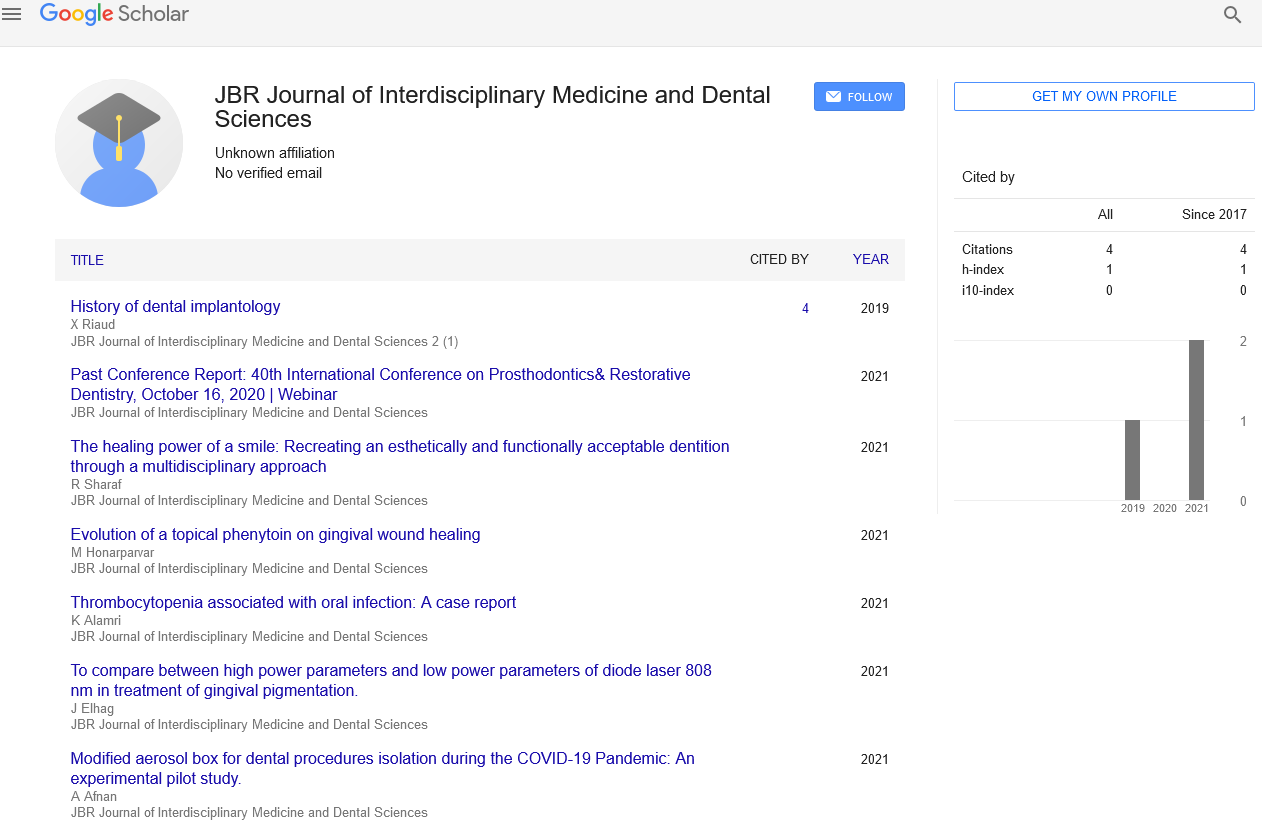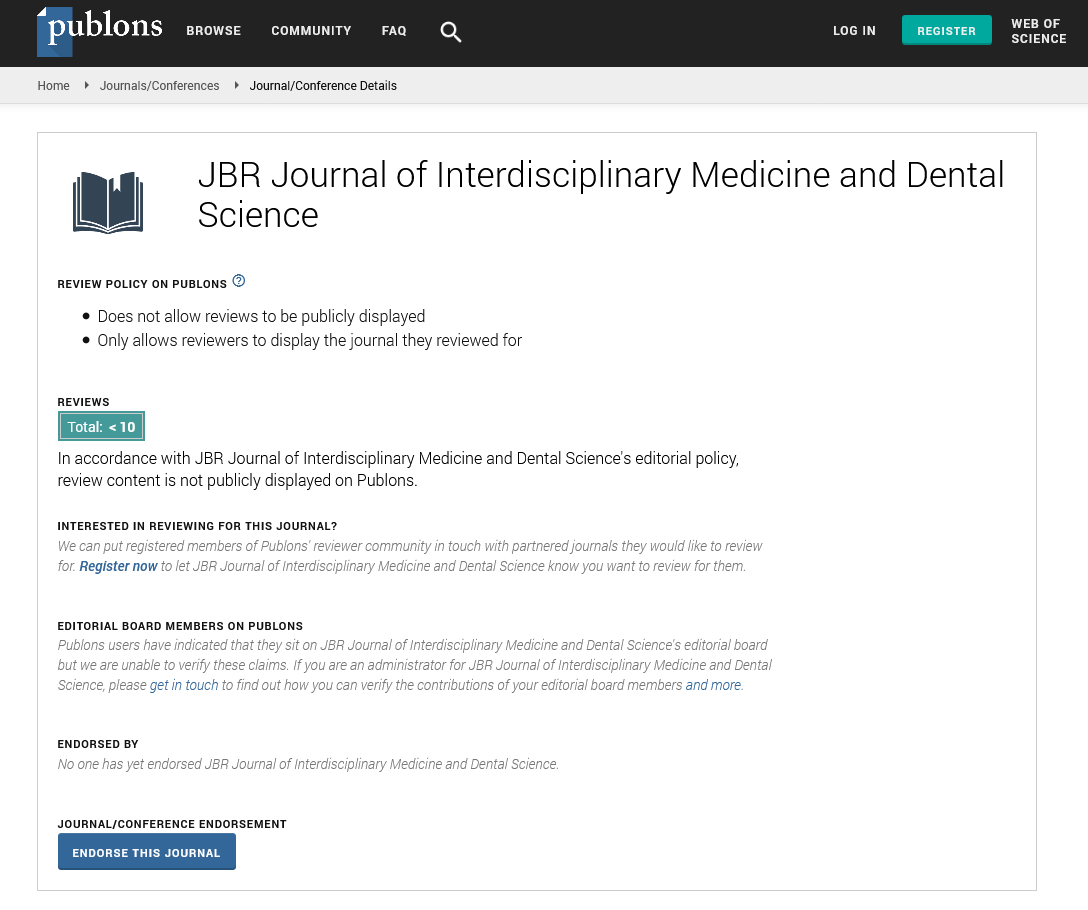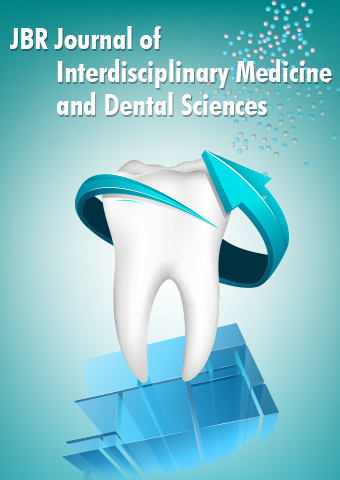Case Report - JBR Journal of Interdisciplinary Medicine and Dental Sciences (2023) Volume 6, Issue 4
Dental Radiography: An Invaluable Tool for Modern Dentistry
Ya Xu*
Department of Dental Radiology, Japan
Department of Dental Radiology, Japan
E-mail: xu_ya14@gmail.com
Received: 01-July-2023, Manuscript No. jimds-23-106446; Editor assigned: 4-July-2023, PreQC No. jimds-23-106446 (PQ); Reviewed: 19-July-2023, QC No. jimds-23-106446; Revised: 24-July-2023, Manuscript No. jimds-23-106446 (R); Published: 31-July-2023, DOI: 10.37532/2376- 032X.2023.6(4).65-67
Abstract
Dental radiography, or dental X-rays, is an essential component of modern dentistry, providing valuable diagnostic and treatment planning information. This article explores the significance of dental radiography in dentistry, highlighting its various types, benefits, and safety considerations. Intraoral X-rays, such as bitewing and periapical X-rays, offer detailed views of individual teeth and their supporting structures. Extraoral X-rays, including panoramic X-rays and cone beam computed tomography (CBCT), provide a broader perspective of the entire oral cavity. The benefits of dental radiography include early detection of dental problems, accurate diagnosis, and treatment planning. It also allows for monitoring of oral health changes over time. Safety precautions, such as the use of lead aprons and thyroid collars, are implemented to minimize radiation exposure. Digital radiography systems further enhance safety by reducing radiation levels and providing immediate image viewing. Dental radiography continues to advance and contribute to comprehensive and personalized patient care in dentistry.
Keywords
Dental radiography • Dental x-rays • Intraoral x-rays • Bitewing x-rays • Per apical x-rays
Introduction
Dental radiography, commonly known as dental X-rays, has emerged as an invaluable tool in modern dentistry. These imaging techniques provide dental professionals with crucial insights into oral conditions that may not be visually apparent during a routine dental examination. By capturing detailed images of the teeth, jawbones, and surrounding structures, dental radiography aids in accurate diagnosis, treatment planning, and monitoring of various dental issues. The advancements in radiographic technology have revolutionized the field of dentistry, enabling dentists to provide comprehensive and personalized care to their patients. This article explores the significance of dental radiography, the different types of dental X-rays, the benefits they offer, and the safety considerations associated with their use. By shedding light on the role of dental radiography, we can appreciate its contribution to enhancing the practice of modern dentistry [1-5].
Types of dental radiography
Several types of dental radiography are commonly used in dental practices, each serving a specific purpose:
Intraoral x-rays: This type of radiography involves placing a sensor or film inside the patient’s mouth. Intraoral X-rays are further categorized into:
Bitewing x-rays: Used to detect cavities, assess bone levels, and examine the integrity of dental fillings.
Per apical x-rays: Provide a detailed view of the entire tooth, including the root structure, surrounding bone, and supporting tissues.
Extra oral x-rays: These X-rays capture images from outside the mouth and are commonly used for evaluating the larger anatomical structures. Examples include:
Panoramic x-rays: Offer a broad view of the entire oral cavity, including all the teeth, jaws, sinuses, and temporo-mandibular joints.
Cone beam computed tomography (CBCT): Provides three-dimensional images of the teeth and jaws, enabling precise evaluation for complex treatments such as dental implants and orthodontics.
Benefits of dental radiography
Early detection of dental problems: Dental radiography enables the identification of dental issues at an early stage when they are not visible to the naked eye. This early detection allows for prompt treatment, preventing further progression and potential complications.
Accurate diagnosis and treatment planning: Detailed radiographic images provide valuable information about tooth decay, bone loss, impacted teeth, infections, cysts, and other oral conditions. Dentists can use this information to formulate effective treatment plans tailored to each patient’s specific needs.
Monitoring dental health: Regular dental Xrays facilitate the tracking of oral health changes over time. Dentists can monitor the progression of dental diseases, evaluate the success of treatments, and adjust treatment plans accordingly.
Safety considerations
Dental radiography employs low levels of radiation, and modern equipment ensures minimal exposure. However, safety precautions are still essential:
Lead aprons and thyroid collars: Patients are typically provided with protective lead aprons and thyroid collars to shield sensitive organs from radiation exposure during X-ray procedures.
Pregnancy considerations: Pregnant patients should inform their dentist to ensure appropriate measures are taken to minimize radiation exposure. Routine dental X-rays are generally safe during pregnancy, but unnecessary X-rays may be postponed until after delivery [6-8].
Digital radiography: Digital X-ray systems significantly reduce radiation exposure compared to traditional film-based methods. These systems also offer the advantage of immediate image viewing, enhanced image quality, and the ability to share images electronically.
Discussion
Dental radiography, also known as dental X-rays, plays a pivotal role in the field of dentistry. These imaging techniques allow dental professionals to visualize and diagnose oral conditions that are not readily apparent during a routine dental examination. By capturing detailed images of the teeth, jawbones, and surrounding structures, dental radiography aids in accurate diagnosis, treatment planning, and monitoring of various dental issues. This article explores the significance, types, benefits, and safety considerations associated with dental radiography[9,10].
Conclusion
Dental radiography plays a pivotal role in modern dentistry, serving as an indispensable tool for dental professionals. Through the use of intraoral and extraoral X-rays, dentists can obtain detailed images of the teeth, jaws, and surrounding structures, enabling them to diagnose and treat oral conditions effectively. The benefits of dental radiography are numerous, including early detection of dental problems, accurate diagnosis, and precise treatment planning. Furthermore, regular radiographic monitoring allows for the evaluation of oral health changes over time, ensuring optimal patient care. While safety considerations regarding radiation exposure are important, advancements in technology, such as digital radiography, have significantly minimized these risks. Dental radiography continues to evolve, providing dentists with enhanced imaging capabilities and facilitating comprehensive and personalized care for patients. As the field of dentistry advances, dental radiography will remain an invaluable tool, supporting dentists in delivering exceptional oral healthcare outcomes.
References
- Aksu M, Kocadereli I. Arch width changes in extraction and non-extraction treatment in class I patients. Angle Orthod. 75, 948–952 (2005).
- Kahl Nieke B, Fischbach H, Schwarz CW et al. Treatment and post retention changes in dental arch width dimensions a long-term evaluation of influencing cofactors. Am J Orthod. 109, 368–378 (1996).
- Stifter J, A study of Pont’s, Howes’ Rees’ Neff’s and Bolton’s analyses on Class I adult dentitions. Angle Orthod. 28, 215–225 (1958).
- Rees DJ. A method for assessing the proportional relation of apical bases and contact diameters of the teeth. Am. J. Orthod. 39, 695–707 (1953).
- Pont A. Der Zahn-index in der orthodontie. Zahnarztuche Orthop. 3, 306–321 (1909).
- Al-Omari IK, Duaibis RB, Al-Bitar ZB et al. Application of Pont’s Index to a Jordanian population. Eur. J. Orthod. 29, 627–631 (2007).
- Dhakal J, Shrestha RM, Pyakurel U et al. Assessment of Validity of Pont’s Index and Establishment of Regression Equation to Predict Arch Width in Nepalese Sample. Orthod J 4, 12–16 (2014).
- Lohakare S. Application of Pont’s Index to Gujrati Population. J Med Sci Clin Res. 6, 171–178 (2018).
- Dalidjan M, Sampson W, Townsend G et al. Prediction of dental arch development: An assessment of Pont’s Index in three human populations. Am J Orthod Dentofac Orthop.107, 465–475 (1995).
- Rykman A, Smailiene D. Application of Pont’s Index to Lithuanian Individuals: A Pilot Study. J Oral Maxillofac Res. 6, e4 (2015).
Indexed at, Google Scholar, Crossref
Indexed at, Google Scholar, Crossref
Indexed at, Google Scholar, Crossref
Indexed at, Google Scholar, Crossref
Indexed at, Google Scholar, Crossref
Indexed at, Google Scholar, Crossref
Indexed at, Google Scholar, Crossref
Indexed at, Google Scholar, Crossref


